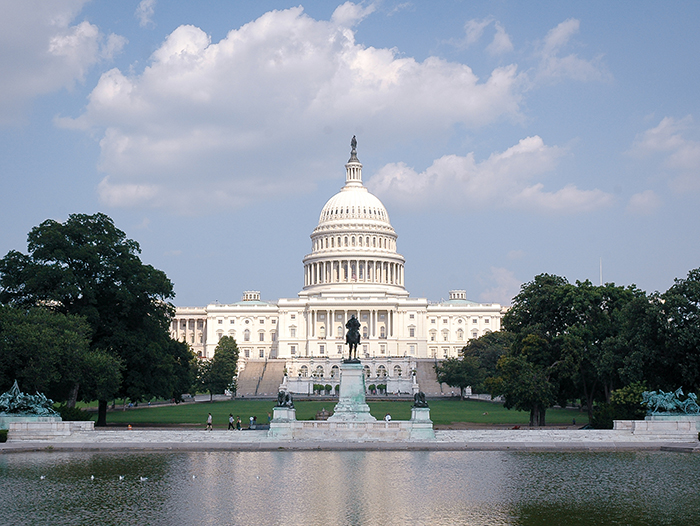President Donald Trump on Wednesday announced that wide-ranging tariffs, including a minimum 10% tariff on all countries, would go into effect, which could lead to higher prices and supply chain uncertainty for many industries, including healthcare.
Details on the tariffs
Trump outlined plans for tariffs as early as his inauguration, but on Feb. 1, the administration formally unveiled an additional 25% tariff on imports from Canada and Mexico and a 10% increase on goods from China. The initial Chinese tariff went into effect on Feb. 4 while Canada and Mexico negotiated a one-month delay.
In early March, the Chinese tariff was raised from 10% to 20%. Mexico and Canada's tariffs went into effect but were shortly followed by a delay for all goods covered under the U.S.-Mexico-Canada trade agreement of 2018.
On Wednesday, Trump announced that new tariffs would go into effect, including a minimum 10% tariff affecting "all countries," according to the White House. In addition, the White House announced that other individualized reciprocal tariffs would go into effect for dozens of countries with whom the United States has a large trade deficit.
For example, a 39% tariff imposed on the United States from the European Union will be matched by a 20% retaliatory tariff from the United States, Trump said. Meanwhile, a 67% tariff imposed by China will be matched by a reciprocal 34% tariff from the United States.
According to the Department of Treasury, the tariffs were calculated by taking the trade deficit the United States has with a country, dividing it by the country's exports to the United States, and multiplying that number by 0.5.
A 25% automobile tariff previously announced by Trump is also set to go into effect, and Trump signed an executive order to close the "de minimis loophole" — which is a trade policy signed into law by Congress allowing shipments valued at less than $800 to be duty-free — for Chinese imports.
"Jobs and factories will come roaring back into our country, and you see it happening already," Trump said during an executive order signing event on Wednesday. "We will supercharge our domestic industrial base, we will pry open foreign markets and rip down foreign trade barriers, and ultimately more production at home will mean stronger competition and lower prices for consumers. This will be, indeed, the Golden Age of Americans coming back."
According to an executive order signed by Trump, pharmaceuticals are among a select list of goods that won't be subject to the higher reciprocal tariffs, and an annex to the order outlines specific drugs and compounds that will be exempt.
However, according to Optum Advisory*'s Derek Kazahaya, "a majority of medical supplies and equipment rely on internationally sourced components that are now subject to tariffs. Even though some pharmaceuticals are exempt, the raw materials behind them may not be, which means that cost increases will have a broad impact across healthcare."
Advisory Board's health policy-related resources
- Follow our coverage to learn how the new administration is approaching healthcare
- How federalism will shape health policy in 2025
- What's happened in Washington (so far) and what policy changes we’re bracing for
- How could Trump’s new tariffs impact healthcare?
- The state of the industry: What healthcare leaders need to know for 2025 (on-demand recording)
How the healthcare industry is responding
Many of the healthcare, pharmaceutical, and medical devices industries have advocated against the trade policy changes since they were proposed. Some research and a survey from Black Book Market Research of healthcare executives have suggested tariffs could lead to higher healthcare costs, disrupt supply chains, and make care less affordable. In the survey, which included 200 respondents, 164 said they expected costs for hospitals and health systems to increase by at least 15% over the next six months due to higher import costs. In addition, 69% of respondents said pharmaceutical costs will increase by at least 10%.
Of the healthcare supply chain professionals surveyed, 90% said there will likely be major disruptions to procurement processes and contract negotiations due to higher costs and pricing volatility. Similarly, 81% of medical equipment manufacturers said there will likely be longer lead times and supply shortages due to higher production costs and import restrictions.
Ninety percent of the hospital finance executives surveyed by Black Book also said they will need to shift increased costs to insurers and patients, leading to higher service charges.
"Hospitals need to pay attention to potential shortages and re-think their purchasing strategies. Traditionally consolidating vendors and standardizing products helped drive savings. While this still may be the case, the new alternative for the moment would be to diversify suppliers and have backups in place to protect hospitals from disruption," Kazahaya said. " Hospitals need to be flexible and move quickly to reassess their strategies, starting with engaging their GPOs and bringing in partners like Optum Advisory Services who specialize in navigating cost pressures," he added.
In addition, a research letter published in JAMA outlined that 411 drug products sold in the United States during Q4 2022 to Q3 2023 were manufactured in Canada, 323 of which are generics, 88 of which are brand-name, and 20 of which are under patent protection. The 411 products represent around $3 billion in sales, which means a 25% tariff would add at least $750 million in costs.
Mark Cuban, the backer of direct-to-consumer drug supplier Cost Plus Drugs, recently said his company "wouldn't have a choice" but to raise prices for generics if the new tariffs were placed on Indian manufacturing.
Scott Whitaker, president and CEO of the med tech trade group AdvaMed, said that if the tariffs were implemented as proposed, they "would act much as an excise tax. It will have a negative impact on innovation, cost jobs, and increase overall costs to the healthcare system."
Meanwhile, the American Medical Manufacturers Association (AMMA) celebrated the "targeted" tariffs and said it would support domestic manufacturing of personal protective equipment.
"For decades, foreign producers have exploited unfair trade practices to flood U.S. markets with low-cost imports," AMMA said in a press release. "They have also exploited trade loopholes, built factories in neighboring countries, and ignored global labor standards to undercut domestic manufacturers and hollow out communities reliant on industrial jobs. Ending these practices is a bipartisan priority as leaders in both houses of Congress have introduced legislation to hold these nations accountable."
Writing for the Harvard Business Review, Willy Shih, a professor of management practice at Harvard Business School, and Chigozie Ukachi, a chemical engineer and Harvard MBA student who previously worked at McKinsey & Company, said the tariffs "could have important strategic implications for a number of industries that depend on volume learning."
"In theory, placing tariffs on imports—for example, on semiconductors or infant industries, such as rare earth metal processing or enzymes and amino acids produced using bio-manufacturing—could give domestic firms the ability to scale and move down the learning curve," Shih and Ukachi wrote.
However, they noted that only works "if those domestic makers are not too far behind and domestic consumers will buy the products from them."
Shih and Ukachi noted that tariffs offer the chemical processing and drug production industries "the opportunity for a … reset, using a less-capital-intensive production process that could more readily leverage AI to optimize yields and reduce unwanted byproducts."
*Advisory Board is a subsidiary of Optum. All Advisory Board research, expert perspectives, and recommendations remain independent.
(Muoio, Fierce Healthcare, 4/2; Bettelheim, Axios, 4/3; Shih/Ukachi, Harvard Business Review, 4/2; Goldman, CNN, 4/3)
Don't miss out on the latest Advisory Board insights
Create your free account to access 1 resource, including the latest research and webinars.
Want access without creating an account?
You have 1 free members-only resource remaining this month.
1 free members-only resources remaining
1 free members-only resources remaining
You've reached your limit of free insights
Become a member to access all of Advisory Board's resources, events, and experts
Never miss out on the latest innovative health care content tailored to you.
Benefits include:
You've reached your limit of free insights
Become a member to access all of Advisory Board's resources, events, and experts
Never miss out on the latest innovative health care content tailored to you.
Benefits include:
This content is available through your Curated Research partnership with Advisory Board. Click on ‘view this resource’ to read the full piece
Email ask@advisory.com to learn more
Click on ‘Become a Member’ to learn about the benefits of a Full-Access partnership with Advisory Board
Never miss out on the latest innovative health care content tailored to you.
Benefits Include:
This is for members only. Learn more.
Click on ‘Become a Member’ to learn about the benefits of a Full-Access partnership with Advisory Board
Never miss out on the latest innovative health care content tailored to you.


